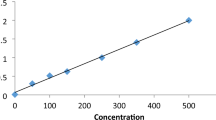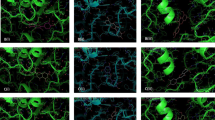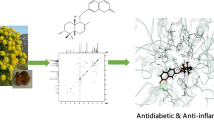Abstract
Bioactivity-guided investigation of the methanol extract of Crepis sancta aerial parts, collected off Al-Tafilah, South Jordan, was applied, and in this study, the extract was explored for its phytochemical components and in vivo antiulcer activity. In addition, a docking study involving the purified compounds with the newly crystalized gastric proton pump (PDB # 5YLU) was performed. In-depth phytochemical investigation using the state-of-the-art chromatographic and analytical techniques was implemented resulting in the identification of two eudesmane-type sesquiterpenoids, 3-oxo-γ-costic acid (1) and its methyl ester (2) together with seven different methoxylated flavonols (3–9) as the extract’s major components. The in vivo antiulcer study at three different doses (50, 100, and 200 mg/kg) against ethanol-induced gastric ulcer in male albino rats, compared to omeprazole (20 mg/kg) as a standard proton pump inhibitor antiulcer drug, revealed that the tested extract, at the middle and the highest doses, featured comparable or even superior activities relative to omeprazole as deduced from histopathological examination, in particular with regard to reducing inflammatory cell infiltration and ceasing mucosal haemorrhage. The tested extract revealed also a dose-dependent reduction in the volume and titrable acidity of the gastric juice together with a dose-dependent increase in the protective gastric mucin content which may explain the noticeable gastroprotective effect. Molecular modelling study of the isolated compounds showed a binding mode similar to the co-crystallized substrate vonoprazan in 5YLU which strengthens the importance of the tested extract as a potential natural remedy for treating gastric ulcer.
Graphic abstract





Similar content being viewed by others
References
Abe K, Tani K, Fujiyoshi Y (2011) Conformational rearrangement of gastric H+, K+-ATPase induced by an acid suppressant. Nat Commun 2:155
Abe K, Irie K, Nakanishi H, Suzuki H, Fujiyoshi Y (2018) Crystal structures of the gastric proton pump. Nature 556:214–218
Ali H-A, Chowdhury AKA, Rahman AKM, Borkowski T, Nahar L, Sarker SD (2008) Pachypodol, a flavonol from the leaves of Calycopteris floribunda, inhibits the growth of Caco 2 colon cancer cell line in vitro. Phytother Res 22:1684–1687
Al-Sayed E, El-Naga RN (2015) Protective role of ellagitannins from Eucalyptus citriodora against ethanol-induced gastric ulcer in rats: impact on oxidative stress, inflammation and calcitonin-gene related peptide. Phytomedicine 22(1):5–15
Alvarez-Suarez JM, Dekanski D, Ristić S, Radonjić NV, Petronijević ND, Giampieri F, Astolfi P, González-Paramás AM, Santos-Buelga C, Tulipani S, Quiles JL, Mezzetti B, Battino M (2011) Strawberry polyphenols attenuate ethanol-induced gastric lesions in rats by activation of antioxidant enzymes and attenuation of MDA increase. PLoS ONE 6:e25878
Amin G, Najarnezhada V, Anassoria E, Mostafavib M, Keshipourc H (2015) Antiulcer properties of Glycyrrhiza glabra L. extract on experimental models of gastric ulcer in mice. Iran J Pharm Res 14:1163–1170
Azizuddin MT, Choudhary MI (2010) Radical scavanging potential of compounds isolated from Vitex agnus-castus. Tur. J. Chem. 34:119–126
Banchroft JD, Stevens A, Turner DR (1996) Theory and practice of histological techniques, 4th edn. Churchil Livingstone, New York/London/San Francisco/Tokyo
Bas G, Erylimaz R, Okan I, Sahin M (2008) Risk factors of morbidity and mortality in patients with perforated peptic ulcer. Acta Chir Belg 108:424–427
Besancon M, Simon A, Sachs G, Shin JM (1997) Sites of reaction of the gastric H+, K+-ATPase with extracytoplasmic thiol reagents. J Biol Chem 272:22438–22446
Chung KT, Shelat VG (2017) Perforated peptic ulcer - an update. World J Gastrointest Surg 9:1–12
de Jesus NZT, Falcao HDS, Gomes IF, Leite TJDA, Lima GRDM, Barbosa-Filho JM, Tavares JF, Silva MSD, Athayde-Filho PFD, Batista LM (2012) Tannins, peptic ulcers and related mechanisms. Int J Mol Sci 13:3203–3228
Flamini G, Antognoli E, Morelli I (2001) Two flavonoids and other compounds from the aerial parts of Centaurea bracteata from Italy. Phytochemistry 57:559–564
Garcez FR, Garcez WS, Hamerski L, de Miranda AC (2010) Eudesmane and rearranged eudesmane sesquiterpenes from Nectandra cissiflora. Quím Nov 33:1739–1742
Grossman MI (1963) Physiology for physician. Am Physiol Soc 1–5
Guarrera PM, Savo V (2013) Perceived health properties of wild and cultivated food plants in local and popular traditions of Italy: A review. J Ethnopharmacol 146:659–680
Han X, Ma X, Zhang T, Zhang Y, Liu Q, Ito Y (2007) Isolation of high-purity casticin from Artemisia annua L. by high-speed counter-current chromatography. J Chrom A 1151:180–182
Hegazy M-EF, Matsuda H, Nakamura S, Hussein TA, Yoshikawa M, Paré PW (2014) Chemical constituents and their antibacterial and antifungal activity from the Egyptian herbal medicine Chiliadenus montanus. Phytochemistry 103:154–161
Khennouf S, Benabdallah H, Gharzouli K, Amira S, Ito H, Kim T-H, Yoshida T, Gharzouli A (2003) Effect of tannins from Quercus suber and Quercus coccifera leaves on ethanol-induced gastric lesions in mice. J Agric Food Chem 51:1469–1473
Kilic O, Bagci E (2013) An ethnobotanical survey of some medicinal plants in Keban (Elazığ-Turkey). J Med Plants Res 7:1675–1684
Mabberley DJ (2008) Crepis L. Mabberley’s Plant-book. Cambridge University Press, Cambridge, p 227
Manez S, Recio MC, Giner RM, Sanz MJ, Terencio MC, Peris JB, Stubing G, Rios J-L (1994) A chemotaxonomic review of the subtribe Crepidinae based on its phenolic constituents. Biochem System Ecol 22:297–306
Mesaik MA, Murad S, Khan KM, Tareen RB, Ahmed A, Choudhary MI (2009) Isolation and immunomodulatory properties of a flavonoid, casticin from Vitex agnus-castus. Phytother. Res. 23:1516–1520
Michalska K, Szneler E, Kisiel W (2016) Structure elucidation of an unusual new sequiterpene lactone glucoside ester from Crepis pannonica. Magn Reson Chem 54:175–177
Ndom JC, Mbafor JT, Wansi JD, Kamdem AW, Mevaa LM, Vardamides JC, Toukam F, Pegyemb D, Ngando TM, Laatsch H, Fomum ZT (2006) Sesquiterpene lactones from Crepiscameroonica (Asteraceae). Nat. Prod. Res. 20:435–442
O'Boyle NM, Banck M, James CA, Morley C, Vandermeersch T, Hutchison GR (2011) Open Babel: an open chemical toolbox. J Cheminform 3:33
OECD (2001) Guideline for testing of chemicals. Guidance no. 423. Acute Oral Toxicity: Acute Toxic Class Method, Paris
Pettersen EF, Goddard TD, Huang CC, Couch GS, Greenblatt DM, Meng EC, Ferrin TE (2004) UCSF Chimera-a visualization system for exploratory research and analysis. J Comput Chem 25:1605–1612
Reitman S (1970) Gastric secretion. In: Frankel S, Reitman S, Sonnenwirth AC (Eds) Gradwohl’s clinical laboratory methods and diagnosis, London, pp 1949–1958.
Sajjadi SE, Ghanadian SM, Rabbani M, Tahmasbi F (2017) Isolation and identification of secondary metabolites from the aerial parts of Stachys lavandulifolia Vahl. Iran J Pharm Res 16:58–63
Salih YK, Abasiyanik MF, Bayyrut N, Sander E (2007) H. pylori infection and oterh risk factors associated with peptic ulcers in Turkish patients: a retrospective study. World J Gastroenterol 13:3245–3248
Sangiovanni E, Vrhovsek U, Rossoni G, Colombo E, Brunelli C, Brembati L, Trivulzio S, Gasperotti M, Mattivi F, Bosisio E, Dell’Agli M (2013) Ellagitannins from Rubus berries for the control of gastric inflammation: in vitro and in vivo studies. PLoS ONE 8:e71762
Sansanelli S, Tassoni A (2014) Wild food plants traditionally consumed in the area of Bologna (Emilia Romagna region, Italy). J Ethnobiol Ethnomed 10(69):1–11
Sepulveda-Boza S, Delhvi S, Cassels BK (1993) Flavonoids from the twigs of Eucryphia glutinosa. Phytochemistry 32:1301–1303
Shim YK, Kim N (2016) Nonsteroidal anti-inflammatory drug and aspirin-induced peptic ulcer disease. Korean J Gastroenterol 67:300–312
Sidahmed HM, Hashim NM, Amir J, Abdulla MA, Hadi AH, Abdelwahab SI, Taha MM, Hassandarvish P, Teh X, Loke MF, Vadivelu J, Rahmani M, Mohan S (2013) Pyranocycloartobiloxanthone A, a novel gastroprotective compound from Artocarpus obtusus Jarret, against ethanol-induced acute gastric ulcer in vivo. Phytomedicine 20:834–843
Stermitz FR, Scriven LN, Tegos G, Lewis K (2002) Two flavonols from Artemisia annua which potentiate the activtiy of berberine and norfloxacin against a resistant strain of Staphylococcus aureus. Planta Med 68:1140–1141
Sung JJY, Kuipers EJ, El-Serag HB (2009) Systematic review: the global incidence and prevalence of peptic ulcer disease. Alim Pharmacol Therap 29:938–946
Trott O, Olson AJ (2010) AutoDock Vina: improving the speed and accuracy of docking with a new scoring function, efficient optimization, and multithreading. J Comput Chem 31:455–461
Van Zanten SJ, Dixon MF, Lee A (1999) The gastric transitional zones: neglected links between gastroduodenal pathology and helicobacter ecology. Gastroenterology 116:1217–1229
Wallmark B, Briving C, Fryklund J, Munson K, Jackson R, Mendlein J, Rabon E, Sachs G (1987) Inhibition of gastric H+, K+-ATPase and acid secretion by SCH 28080, a substituted pyridyl(1,2a)imidazole. J Biol Chem 262:2077–2084
Winzler RJ (2006) Determination of serum glycoproteins, method of biochemical analysis. Wiley, pp 279–311
Woo J-H, Ahn J-H, Jang D-S, Lee K-T, Choi J-H (2017) Effect of kumatakenin isolated from cloves on the apoptosis of cancer cells and the alternative activation of tumor-associated macrophages. J Agric Food Chem 65:7893–7899
Xie X-Y, Wang R, Shi Y-P (2014) Flavonoids from the flowers of Matricaria chamomilla. Chem Nat Comp 50:910–911
Yuan Y, Padol IT, Hunt HR (2006) Peptic ulcer disease. Am Fam Physician 76:1005–1012
Author information
Authors and Affiliations
Corresponding authors
Ethics declarations
Conflict of interest
The authors declare that there is no conflict of interest.
Additional information
Publisher's Note
Springer Nature remains neutral with regard to jurisdictional claims in published maps and institutional affiliations.
Electronic supplementary material
Below is the link to the electronic supplementary material.
Rights and permissions
About this article
Cite this article
Ebada, S.S., Al-Jawabri, N.A., Youssef, F.S. et al. In vivo antiulcer activity, phytochemical exploration, and molecular modelling of the polyphenolic-rich fraction of Crepis sancta extract. Inflammopharmacol 28, 321–331 (2020). https://doi.org/10.1007/s10787-019-00637-x
Received:
Accepted:
Published:
Issue Date:
DOI: https://doi.org/10.1007/s10787-019-00637-x




